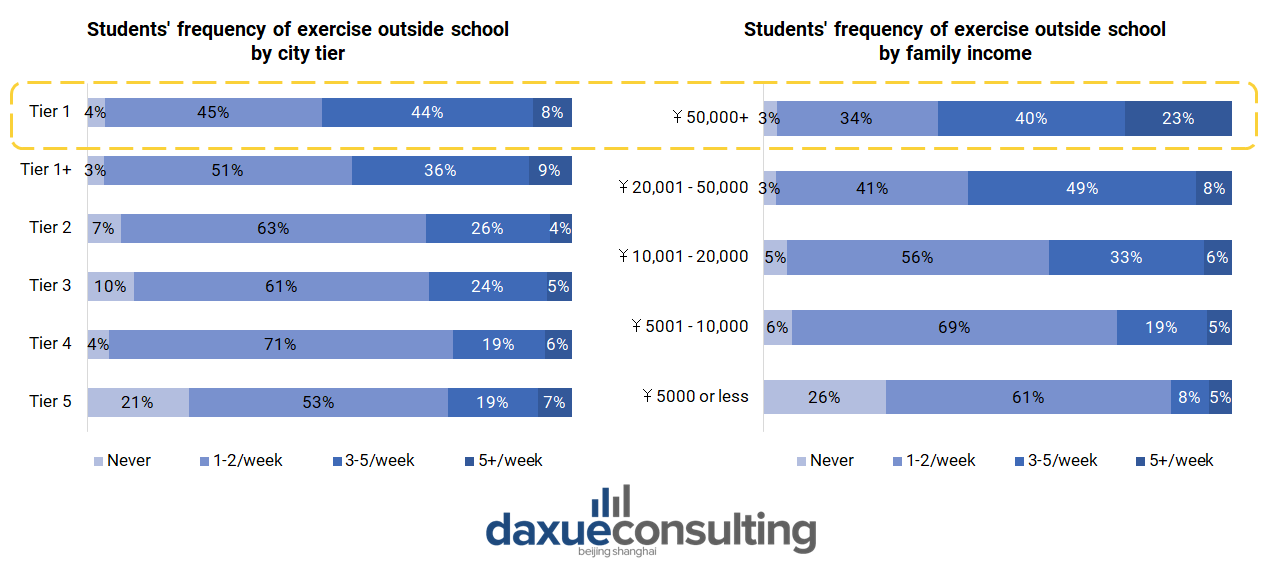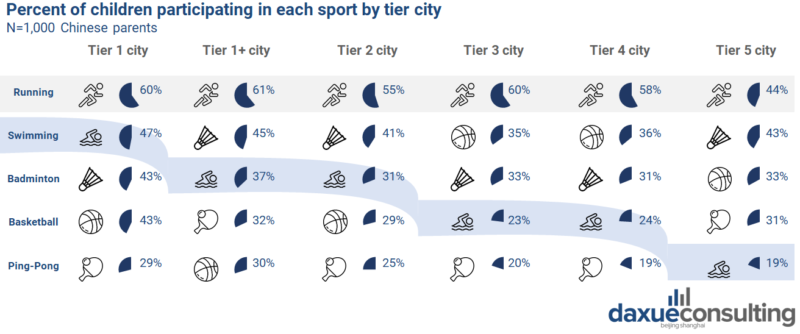Up until late August 2021, most Chinese students’ after school hours were spent bent over the books at tutoring classes. This was largely due to the academic pressure created by an exam-oriented learning culture and parents’ well intentions to set their children up for success. However, with the signing of the Double Reduction policy in August, which banned after-school tutoring for the sake of reducing academic pressure on children, a whole new economy of after-school activities in China broke wide open. In 2019, China’s after-school tutoring market was 800 billion CNY in size.
Now, with many parents still hoping to re-allocate their tutoring budget to new activities that will contribute to their children’s development, it is an opportunity for companies in sports and the arts to set sail in this blue ocean. This is why we looked into the youth sports market in China, surveying 1,000 Chinese parents on their children’s sports habits and their own beliefs on the importance of sports in their children’s lives.
Download our full report on China’s youth sports market below
In a culture that long de-emphasized the importance of physical education and sports, what does it take to convert Chinese parents to enroll their children in sports?
Since the Tang dynasty, Chinese culture favored academic prowess over physical fitness, and even showed contempt to military officers who exhibited high levels of physical fitness. During Gen X’s upbringing in the 80’s and 90’s, physical education was considered non-essential and prioritized last in school. As a result, Physical Education (PE) classes were often repurposed to core classes like Math and language, and when PE class did occur, it was militaristic in style, emphasizing discipline rather than fun. This is the context in which today’s Chinese parents grew up. Hence, it’s no surprise that our survey data of 1,000 Chinese parents showed more weight on the importance of their children’s academics than fitness.

Source: Daxue consulting survey, November 2021, n=1,000, Chinese parents perceptions of the importance of fitness vs. academics.
Yet, despite the overt emphasis on academics over sports, the times are changing, and the authorities, parents, schools and children alike are realizing the important role of athletics in development.
The importance of sports in Chinese schools is growing, starting with middle school
While after the Double Reduction policy, physical education (PE) is being considered to be added to the National University Entrance Exam (高考), it has had a place in the National High-School Entrance Exam (中考) for decades. This shows an emphasis on the importance of PE for middle schoolers, but lack thereof for high schoolers. Interestingly, Chinese youths’ perceived importance of physical activity also decreases with age.
In a survey of over 4,000 Chinese students in March 2021, 41.8% of middle school respondents stated exercise was “very important”; however this was true for only 31.8% of high-schoolers and 29.6% of University students. When asked why they haven’t been able to workout, the top reasons can be summarized as unfamiliarity with sports and the belief that working out is too complicated. Our own survey data also confirms this reality, 47% of 7-12 year olds in China exercising three or more times a week, while only 27% of 13-18 year olds did so.
What sports are gaining traction among Chinese youth?
The answer to this question is different depending on income, city-tier and region. Overall, sports is more valued among families of privilege, in terms of both income and city-tier.

Source: daxue consulting survey on youth sports habits in China, higher income and higher tier city children exercise more
However, families from lower-tier cities and low-income families find themselves in a dilemma between allocating time for sports and academics. Academics, specifically the University Entrance Exam (高考) is the most clear path for social mobility in China, as where students go to university is dependent on, and only on, that test. Additionally, to reduce population migration, the scores necessary for rural province students to get into the top University’s is higher than what’s necessary for a student from high-tier cities like Beijing and Shanghai. But if physical education is introduced to the Gaokao, and if tutoring is banned, lower tier cities will become a massive growth point for China’s youth sports market.

Source: daxue consulting survey of Chinese parents on their children’s physical activity.
Running was the most practiced sport among all cities, incomes and regions, likely because it requires the least amount of equipment. On the contrary, swimming has become the more popular in high-tier cities, especially in the southern regions, nearly half of respondents in the Guangdong region reported their children swimming.

Source: daxue consulting survey on youth sports in China, 1,000 parents from various cities told us what sports their children participate in
Why we are optimistic about the future of China’s youth sports market
China’s policies are driving the youth sports market. In August 2021, the State Council issued the 2021-2025 National Fitness Plan, which aims to have 38.5% of the population exercise regularly, increasing the number of sports instructors in the country to two for every one thousand residents, and push the sports industry to reach 5 trillion yuan.
Additionally, China’s winter sports market is also booming. The government developed a 2016 plan for the winter sports industry to involve 300 million people, generate 1 trillion RMB in revenue, and incorporate 5,000 primary and middle schools in Northern provinces and the building of five national ice and snow industry bases. From 2002 to 2019, the number of ski resorts in China climbed from 130 to 770.
What brands should know when entering China’s youth sports market
Focus on sports education. Like with entering any maturing market, education is key. Consumers need to understand the why and the how behind your product. Especially for sports, the focus should be on the ‘how’. When Chinese teenagers were asked in a survey why they do not do sports, the top reasons were ‘Exercise is too complicated’, ‘No favored sports’, and ‘Don’t know how’, these survey choices even out-ranked reasons related to studying being priority. Brands will have to play a role in educating the public on how to perform the sports and use the equipment.
Explain the benefits to parents. The marketing message of sports brands in China must explain the ‘why’. As our research shows, most Chinese parents are not so enthusiastic about their children doing sports, especially since they grew up during a time when fitness was seen as unnecessary. Hence, many parents are behind on the health and cognitive benefits of their children’s fitness. Any sports program targeting children needs to have the parent in mind, and the parent cares about their child’s wellbeing.
The most open age to target is 7-13. Middle school aged children have much less academic pressure than their high-school counterparts, and research shows they are more interested in sports and physical activities. This isn’t to say that there is no hope for Chinese high-schoolers, in fact, high-school aged teens will also be a growing market as after-school tutoring is now banned.
Different incomes, city-tier and regions have different needs. Low tier cities and remote regions are lacking sports infrastructure and tend to prefer badminton, dancing and ping pong, while urbanites prefer swimming, tennis and team sports. Higher tier cities are also likely to have received higher quality education when it comes to sports.





